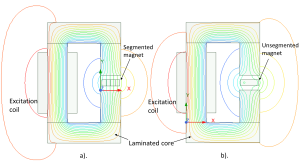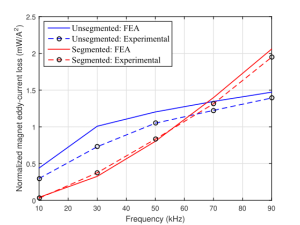Investigation of magnet loss in an interior Permanent magnet motor
Samith Sirimanna with advisor K. Haran
Rare earth permanent magnet materials such as NdFeB magnets are the common choice for electric vehicles due to their availability and strong magnetism as well as their resistance to demagnetization. These magnets have a high electrical conductivity value, around 0.5–0.9 MS/m, which can produce significant eddy current losses. Stator slot harmonics and inverter pulse-width modulation harmonics excite these metallic magnet blocks to generate eddy current losses. A common strategy is to segment the magnets and reduce the magnet losses to lower the rotor temperature rise.
However, skin effect causes the expected loss-reduction effects from segmentation to reverse, resulting in more losses at higher segmentation. A calorimetric test setup was designed to validate this result at the component level using unsegmented vs four-segment magnets. Figure 1 shows the finite element analysis (FEA) C-core model used to validate the results, and validation results. As seen, the cross-over frequency between the unsegmented and segmented magnets agrees closely.
The same idea is then tested at the rotor level using specially fabricated rotors. Both the calorimetric and FEA methods integrated with actual current waveforms were used to validate the results.

